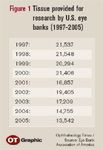Article
Eye tissue issues could threaten ophthalmic research
Rockville, MD-Vision and ophthalmic researchers in the United States have been narrowing their specifications for requested human eye tissue at the same time that the country's eye banks have been facing federal regulations and state laws that make it more difficult for them to meet these needs. The result is a reduction in tissue available for research. But researchers and eye banks can take steps to address this situation. Without such action, future research into some blinding diseases may be threatened.

So concluded the Research Tissue Acquisition Working Group (RTAWG) of the Association for Research in Vision and Ophthalmology (ARVO), Rockville, MD, after a survey of U.S. ARVO members.


The decrease has particular implications for research in age-related macular degeneration and glaucoma, said Christine A. Curcio, PhD, corresponding author of the paper. "Macular degeneration, an advanced form of which now has treatment options, still lacks a laboratory animal model that displays the full range of pathology typifying the human disorder. Thus, human tissues are particularly critical," said Dr. Curcio, professor of ophthalmology at the University of Alabama School of Medicine in Birmingham.
Also, she said, "My colleagues in glaucoma research tell me that they still require human trabecular meshwork and lamina cribrosa of the optic nerve, because these structures are not adequately modeled by widely used laboratory animals."
More researchers today want tissue that has been preserved within less than 24 hours of donor death (62% in 2003 versus 26% in 1993), but federal regulations and state laws are lengthening the amount of time it takes eye banks to meet these requirements in order to offer tissue, as well as making it more difficult to collect tissue, the working group found.
"Increasing regulations tend to have the effect of reducing the pool of available tissue," Dr. Curcio said. "Two examples that come to mind are as follows: Tissue coordinators from eye banks are required to determine the social history of donors, which entails asking donor families potentially embarrassing questions about the sexual practices and possible drug use of the deceased. Other regulations have increased the number of required blood tests, which now include hepatitis B core antibody in addition to hepatitis B surface antigen and syphilis, despite the fact that transplant of the avascular cornea is much less likely to promote transmission of the relevant infectious agents than highly vascularized organs like the kidney."
The pool of available tissue is reduced further by state laws prohibiting whole-eye enucleation when the cause of death of a potential donor was violent or suspicious, the working group stated.
Newsletter
Don’t miss out—get Ophthalmology Times updates on the latest clinical advancements and expert interviews, straight to your inbox.




